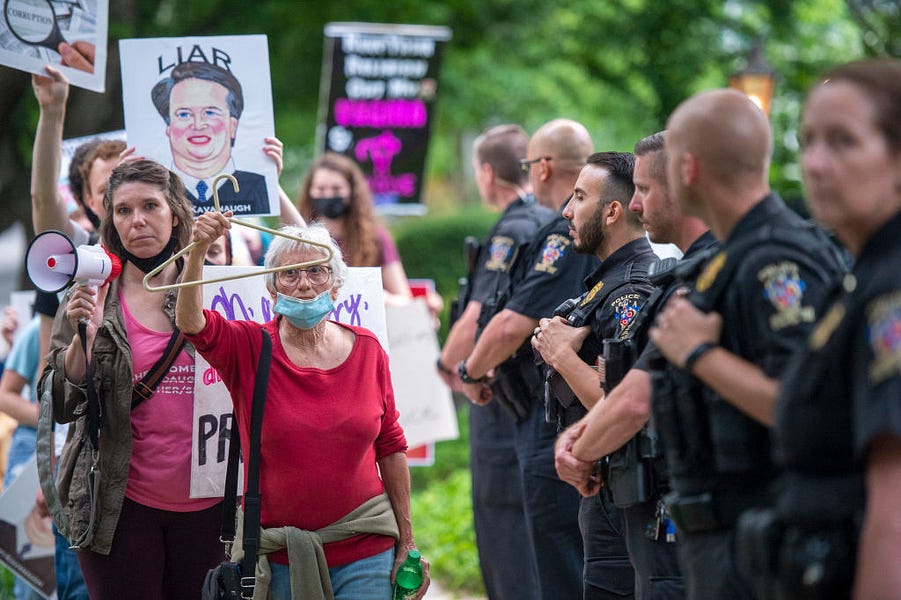Last month, Justice Samuel Alito’s draft opinion overturning Roe v. Wade leaked into public view. This month a man tried to assassinate Justice Brett Kavanaugh. Police arrested the suspect outside Kavanaugh’s home (he was able to find Kavanaugh’s address online), and he was carrying a handgun, a knife, pepper spray, zip ties, and tools useful for breaking into the Kavanaugh home.
As the disturbing news reports filtered out, I had two immediate responses. First, because I’d just debated the topic on the New York Times “Argument” podcast, I thought: This is why you don’t dox public figures. By exposing a person’s home address to the public, you expose it not just to those who want to peacefully protest, but also to those who wish to do you harm.
But my second thought was more important, and it’s what I want to address today. I thought no one should be surprised at the attempt or the target. After all, in some quarters, Justice Kavanaugh has become the “right” person to hate, and if enough people hate a person, then threats and ultimately violence are the inevitable result.
I’d like to introduce you to a term you may not have heard before. It’s called “stochastic terrorism,” and it’s deeply challenging—both as a concept and as a reality—to both sides of our partisan divide. You can find a good short definition of the term in a recent piece by Todd Morley in the Small Wars Journal. He described it as “a quantifiable relationship between seemingly random acts of terrorism and the perpetuation of hateful rhetoric in public discourse, accompanied by catastrophising and fear generation in media sources.”
Another, shorter definition is the “incitement of a violent act by the public demonization of a group or individual,” and it refers to a “pattern that cannot be predicted precisely but can be analyzed statistically.” In other words, “a specific act against the demonized person or group cannot be forecast, but the probability of an act occurring has increased due to the rhetoric of a public figure.”
The concept is both common-sense and controversial. The common-sense element is easy to explain. If you’re a normal person and five people hate you, what are the odds you’ll face targeted violence? Unless you’re engaged in criminal activity yourself (and the five people who hate you are other criminals), then the odds are almost impossibly low.
But what if 50,000 people hate you? Or five million? Then the odds change considerably, until they reach a virtual certainty that you’ll face a threat of some kind.
I’ve explained the concept as working like a funnel. At each new step from rhetoric to action, engagement narrows and intensifies. Lots of people might “just” talk. Fewer people actually act. But the more people who talk, the more people who act. We can easily recognize this reality in extremist movements. They rarely spring from healthy communities.
For example, we’ve long recognized that the Middle East is awash in anti-Semitism. According to the Anti-Defamation League, a horrifying 74 percent of citizens of the Middle East harbor anti-Semitic attitudes. No other region comes close. The next-most anti-Semitic region is Eastern Europe, where 34 percent of citizens hold anti-Semitic ideas.
The vast majority of anti-Semites will never be violent. But amongst such a vast pool of people, there will be some who will believe words are simply not enough. A small number will raise money for violent causes. A smaller number will join extremist organizations. A smaller number still will take up arms. Is it any wonder that Israel faces persistent threats of terrorist violence?
Thus one of the challenges of containing extremism lies not just in addressing the most intense individuals at the bottom of the funnel but also the prevalence of the terrible ideas at the top.
When I was researching my book, which argues that America might face a secession crisis, I talked to a number of people who were experts in civil conflict in developing nations who are increasingly alarmed by the dynamics that exist here at home. There is nothing unique or special about Americans that makes us immune from the same tidal forces that have torn other nations or regions to pieces.
Here, as elsewhere, hatred is leading to a terrifying atmosphere of menace and threat. On Friday, Andrew Sullivan reposted an October essay arguing that personalizing politics was dangerous. Threats were migrating from online spaces to public figures’ homes. Read these incidents and ask, How many do I remember? How many did I ever hear about?
Not content with marching in the streets to air complaints, demands, and grievances as a public spectacle, demonstrators of all kinds increasingly seek out the private homes of public figures to hound them intimately and personally. In the past year or so, the examples have mounted quickly. The mayor of Portland had to move house because activists besieged his condo building, breaking windows of other people’s offices and throwing burning debris into them. The mayors of St. Louis and Buffalo were also driven from their homes, and Chicago’s mayor was under constant threat: “[Lori] Lightfoot already receives 24/7 protection from cops including officers stationed at the residence.”
Andrew then talks about additional incidents in Pittsburgh, Philadelphia, Oak Park, Oakland, Sacramento, and Seattle before he turns his attention to the right:
Although not as persistent or as widespread as the far left’s invasion of the privacy of public figures, the far right is not innocent either. LA Mayor Garcetti’s residence was targeted by anti-lockdown activists; LA County’s public health director was also targeted at home; some folks brought menacing tiki-torches to the Boise mayor’s home; in Duluth, Trump supporters organized 20 trucks to circle the mayor’s home. Over the new year, Nancy Pelosi’s private home was vandalized, graffiti written on her garage door, and a bloody pig’s head was thrown into the mix for good measure.
Of course the ultimate recent example of hatred and fury spawning violence is the attack on the Capitol on January 6. It was perhaps the most predictable spasm of violence in recent American history. One cannot tell tens of millions of Americans that an election is stolen and that the very fate of the country hangs in the balance without some of those people actually acting like the election was stolen and the nation is at stake.
But if the concept of stochastic terrorism is so obviously connected to human experience, why is it controversial? In part because it aims responsibility upward, and it places at least some degree of moral responsibility for violent acts on passionate nonviolent people. While criminal responsibility may rest exclusively with the person who carries the gun (or his close conspirators), moral responsibility is not so easy to escape.
That brings us back to Justice Kavanaugh. It’s hard to think of a single public figure who’s been subject to more sustained and furious attacks on his character than Kavanaugh, and I say this as someone who took Christine Blasey Ford’s allegations against him quite seriously. My position was simple—if there was a preponderance of evidence that her claims were true, then he shouldn’t be a Supreme Court justice, even if she was talking about an incident that occurred decades ago.
(If you want to read my evaluation of the evidence against him, I recommend this long piece I wrote in October 2018 in National Review.)
But what should have been a sober look at a serious claim turned into a media frenzy the likes of which I’ve rarely seen. It culminated in a transparently unserious gang rape allegation brought forward by lawyer Michael Avenatti—now disgraced and imprisoned, but then championed as a Resistance hero by many on the left. The allegation started to fall apart almost immediately, but that didn’t stop people with immense followings from both believing it and ridiculing and attacking those who expressed skepticism.
The result was that millions of Americans didn’t just dislike Kavanaugh, they hated him. They believed the worst about him. When he was hated at that scale, threats were inevitable, and an attempt on his life was likely. The terrible math of stochastic terrorism worked again.
One of the things that makes me concerned for the fate of our country is the reality that America’s partisans are both quite eager to assign blame for intimidation and violence to their political opponents and indignant when told that their own rhetoric contributes to our cultural decline. And so we live in a world where both Brett Kavanaugh and Christine Blasey Ford faced an avalanche of threats. And not just them—virtually any person who possesses a public voice on matters of public concern can tell stories of times when they felt afraid.
Our nation cannot withstand this level of vitriol. It will lead to more violence, and when it does, our most vicious partisans will disclaim any responsibility. “How dare you blame me,” they’ll say. “Everyone knows the man who pulls the trigger is responsible for his own crime.” Yes, legally, he bears the blame. But words still matter. They inspire action, and when angry partisans see people they publicly hate face danger and death, they should feel shame for the culture they helped create.
One more thing …
Earlier this month, I filed a Supreme Court amicus brief on behalf of fifteen family policy organizations in a case called 303 Creative v. Elenis. It’s going to be argued next Supreme Court term, and the issue at stake is whether the state of Colorado can compel a web designer to design a website celebrating a same-sex wedding. I say no. Here are my opening paragraphs:
This case comes to the court at a critical moment. There is an increasing collision between generations-long consistent protection of the First Amendment in this Court and a culture that increasingly yields to the impulse to dominate political opponents, censor their expression, and even compel them to host speech or engage in speech with which they disagree.
It is one thing if the pressure to conform remains cultural rather than legal. While online attacks are difficult to endure, one can persevere and still speak. While peer shame can sting, only a small amount of courage is required to preserve one’s public voice.
State censorship and compulsions, however, are different matters altogether. It is the state that wields the power of the sword. It is the state that can bar entrance into the marketplace of ideas. It is the state that can dictate whether a citizen can open a business or earn a living. Thus, it is the state that is the eternal threat to liberty. Only the state can truly suppress the American idea.
The First Amendment thus erects a high wall around private speech and individual conscience. It does not ask if speech is wise, good, popular, or fashionable before it grants its protection. Popular speech does not need a constitutional shield. It is the dissenter who truly values the First Amendment, and it is for the dissenter that the First Amendment exists.
Read the whole thing and review my work in the comments. Persuaded? If not, why not?
Another thing …
You’re not going to want to miss this week’s Good Faith podcast. Curtis and I hosted Christianity Today’s Russell Moore, and we talked about the upcoming Southern Baptist Convention Annual Meeting in Anaheim, California, the SBC sex abuse report, the crisis in American pastors, and the Christian call to be strange (but not crazy). It was a great conversation, and I hope you enjoy it as much as I did.
One last thing …
Let’s do something a bit different and end with an inspiring moment rather than an inspiring song. You may not know this, but I’m a longtime fan of professional wrestling. I went to my first sold-out show in Rupp Arena in Lexington, Kentucky, when I was 10 years old. In college I spent a ridiculous sum of money to go see Hulk Hogan wrestle Andre the Giant. The WWE gave us the greatest living American celebrity, Dwayne “The Rock” Johnson.
I don’t keep up as much as I used to (it’s hard to simultaneously keep up with the NBA, college football, the NFL, superhero movies, the Star Wars franchise, Game of Thrones, every Tolkien property under the sun, British crime dramas, and the WWE), but did you know that nobody has granted more Make-a-Wish “wishes” than John Cena? And did you know that he did this?
It’s one of the most touching things I’ve seen in a long time. There is still much good in this world.









Please note that we at The Dispatch hold ourselves, our work, and our commenters to a higher standard than other places on the internet. We welcome comments that foster genuine debate or discussion—including comments critical of us or our work—but responses that include ad hominem attacks on fellow Dispatch members or are intended to stoke fear and anger may be moderated.